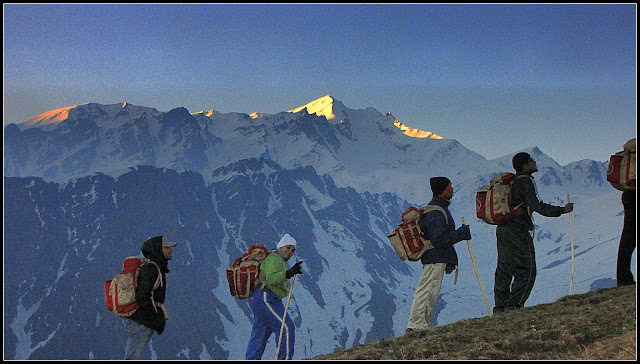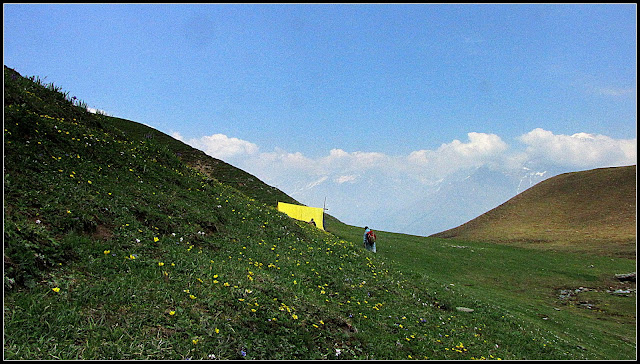Sar Pass is a pass at 13800 ft altitude
on the hill range overlooking river parvati. The trek starts and ends at
the road along the river near Barshaini village, at any of the bridges
across the river. You walk in 6-7 days, from around 7000 ft altitude to a maximum altitude of 13800 ft before coming back down to road level. The trek is full of steep trails through dense forest and meadows before breaking through the tree line and onto snow.Steep trails can cause slipping if it rains.
Youth Hostel Association of India organizes this trek every year for it's members. Membership can be applied for and obtained online
and it can be an yearly membership or lifetime. I had got my lifetime
membership card home delivered few years back, applying online, for Rs
1500/-.
The trek also can be booked online.
In 2013, the bookings opened in Nov 2012 and the program is of 11 days,
ex Youth Hostel Kasol. One batch reports each day from 01 May till 5th
June, 2013 and online booking charges were Rs.3400 + Booking Amt: Rs 255. This
amount includes food, lodging in tented camps (capacity 10 participants
each), cost of guides etc. Dusty blankets over tarpaulins and plastic sheets form your bed
inside the tents and to counter the cold you get two blankets (at Kasol)
or sleeping bags (at other camps). At these camps, as a supplement to
the sleeping bags, you also get either one blanket each or 4-6 blankets
per tent, depending on the availability. One sleeping bag liner (cotton)
is issued to you at base camp, which you can carry on the trek.
You
will face moderate cold on the trek and while a T shirt and a wind
cheater will suffice in the day, you may need a warm jacket/ sweater/
thermal inners with a woolen cap in the evenings and night. A waterproof
poncho or raincoat or a mere 'rainsheet' would suffice for the
occasional rain. Do not carry too much stuff as you are going to repent
it when you struggle in rarer air at high altitudes. There is no real
point in thinking of taking a bath at places other than Kasol although
you may be offered hot water (on payment) by villagers at Khora Thatch and Zirmi
where a makeshift bathing place is made in open wrapping a plastic sheet
on 4 wooden poles. Having said that, few people more hygienic minded than
me, did make use of these facilities.
So
one extra T shirt, one pair of trousers, one thin jacket, one
windcheater, goggles, woolen cap, spare socks, rain sheet/ raincoat/
poncho, a tiffin and a tumbler, some vaseline, sunblock, toothbrush and
paste, a pair of slippers, LED torch/ headlamp, camera and spare
battery makes the list of things to carry. Carry a large plastic trash bag to be put inside the rucksack as a waterproof liner. You can make a cheap rucksack cover by inverting a clear large plastic bag over it and cutting small slits to take out the straps. The YHAI camp volunteers check your rucksack for weight and ask you to limit it to 3.5-4 kgs.
You
are supposed to carry your own utensils to eat in and a tiffin to carry
packed lunch. It is advisable to carry only a plastic or steel tumbler,
a spoon and a plastic tiffin with a tight fitting lid, which may have
two (preferably three) pressed compartments. Normally you get dal, one
vegetable (dry or with curry), chapati, rice, papad, pickles and a sweet
dish (sevaiyan, kheer etc) at the camps. With a tumbler (for sweet
dish?) and a tiffin with pressed compartments, you can manage your food.
The packed lunch is a simpler affair with only chapatis/ pooris with a
dry vegetable and pickle. Washing the tiffin can be a pain, in the cold
water at high camps. You can use tissues and soap strips to rinse the
yellow grease off the tiffin. Remember to expose the tiffin to air and sun when you can, to get the sour smell off it.
While
people trek in all kind of shoes, including sneakers, yet I would
recommend high ankle water resistant trekking shoes like Quechua Forclaz 500
available online for Rs 3999/- (cheaper if you can get it from cash and
carry Decathlon stores in Bengaluru or elsewhere. I hear there is one in
Mumbai too). I can not emphasize enough on the need to have deep
grooved soles which grip well on steep inclines where you may face wet
slippery mud if it rains. You will also walk at least one day in snow,
traversing across steep slopes where sneakers and such other urban shoes
would show their limitations and you would be unsure of the grip.
When you book the trek, you are allotted a batch which typically is named SP-nn where nn is the reporting date. So mine was SP26 with reporting date as 26th June. The trek takes a total of 11 days:
Day 1: Reporting at base camp, Youth Hostel Kasol (6500ft)
This day is an open day, merely for reporting. Normally
participants arrive by Bus and get down at Bhunter, on the Manali
Highway. Bhunter has the local airport and the road towards Manikaran
takes off from here, to the right, over a bridge across the sangam of
rivers Beas and Parvati. Remember to tell your bus driver to drop you
off nearest to Bus stand Bhunter as there is another dropping point
called Manikaran Chowk, which is further ahead, closer to the
bridge. From 615 AM onwards, you get buses every half an hour or so, to
Kasol, from the Bus stand at Bhunter. I am told that the last bus is
around 6 pm, though this has not been verified. Taxis are available but are costly.
The fare is Rs 35 for a 30 km trip and YHAI camp is well known by the
bus drivers. The bus ride takes anywhere from 1.5 to 2 hours. Be
prepared for frequent stops as passengers are picked up and dropped all
along the route. The road is narrow and bumpy and there would be
occasional stops to let the other vehicles cross or pass and few traffic
jams may also occur. The camp is half a Km before the main centre of
tiny Kasol. You will find a board on the left of the road, where steps
have been made to go down to the camp.
As
you enter the camp there is a battery charging station on the right,
along the hillside where about 15-20 phones or camera batteries can be
charged at one time. (thefts have been reported, so you better keep
close by while you are charging your stuff). A reception counter is
straight ahead where you are supposed to produce your booking
acknowledgement slip, medical certificate and two photos. You may be
required to fill up a reporting form and a two leafed card, affixing the
photos on each. You will carry this card with you on the trek. Actually the group leader carries it, getting it stamped and signed at all camps en-route. This card forms the basis of your completion certificate on return. At base camp, you would be allotted a tent where you will meet
other participants of your batch or occasionally, few participants from other batches.
You
will be issued two blankets (beware of the dust), a sleeping bag liner
and a rucksack and you would have to sign for this stuff in a register.
Remember to get these items struck off as you return the blankets before
leaving for the trek and the remaining stuff when you come back from
the trek and check out.
Timings for food etc., are displayed on a signboard. You
can leave the camp (till 7 pm) and visit Kasol (few hundred metre) after
dropping off your card into a drop box at reception. Kasol has tour
operators for bus bookings, general stores, eateries and misc shops for
almost all your needs. There are also hot baths on payment of 40 Rs.
Kasol
camp has separate toilet and bath block with very basic amenities. The
floor of baths almost always gets flooded because participants throw
soap strips and other debris inside the toilet. Indian type (where you
squat) toilets give an unpleasant stench. There are two wash basins with
mirrors and two urinals on the men side. Water is directly pumped from River Parvati
and is muddy.
Drinking
water is separately stored in two Sintex tanks (with taps) outside this
block. A large covered space has food counters and plastic tables where
you stand and eat. This area is also used for briefings etc, for which
participants bring tarpaulins and spread these on the bare ground to sit
upon.
There is a structure in the rear where you can buy basic hunter shoes, socks and rain sheets from the lady living on the first floor. The ground floor has storage rooms where you can deposit spare
luggage before going on the trek. This is done on the previous evening
of your departure. Two slips are filled in for each item, one of which
is pasted inside a pocket of the item (and not on outer surface, to prevent the slip getting dislodged and lost) and the other part of the slip remains with you, to
claim your luggage on return.
Evenings have camp fire, where the incoming batch performs (music, songs, jokes etc) for everyone. The batch checking out is given their certificates at this time.
Day 2: Acclimatization and Orientation
The
morning starts with some stretching exercises for which you are taken
to a ground approximately a km away. Do not forget to take your rain
sheet/ poncho etc., if there are clouds. On return, after breakfast, you would line up
and applaud the batch leaving for the trek. After this, you fill the
rucksack given to you with a filled water bottle and the two blankets
given to you. Thereafter, you are taken for an acclimatization walk. An
orientation talk is also given by the camp in-charge on this day. The
group chooses a leader, a co-leader and an eco-leader. The evening is again ended with a camp fire.
Some
participants report on this day, who are then taken on the
acclimatization walk on the next day, foregoing the rock climbing
session.
After
morning exercises and seeing off yet another batch starting the trek, you are taken for a
rock climbing session in the forenoon and a rappelling session in the
afternoon. The order can change. Rock climbing is not really an activity which can be done in
trekking shoes and you can't blame the participants for not being very
enthusiastic.
The
rappelling session is of some use as you can later, use a rope to come
down a small patch of almost vertical path cut in rock on the day when
you trek from Biskeri Thatch to Bhandak Thatch.
The evening is again ended with a camp fire.
The remaining program is as under, which is discussed in detail in subsequent posts:
Day 4: By bus to Ghatigadh (7400ft)- 13km, 1hr & trek to Youth Hostel Galgithatch (actually its Jalgi Thatch) (8500ft)- 5km, 4hr
Day 5: Trek to Youth hostel Khora Thatch (9800ft)- 7km, 5hr
Day 6: Trek to Youth hostel Zirmi (11000ft)- 6km, 5hr
Day 7: Trek to Youth Hostel Tila Lotni (12500ft)- 6kms, 4hr
Day8 : Trek to Youth Hostel Biskeri Thatch (11000ft) via SAR Pass (13800ft)- 9km, 6hr
Day 9: Trek to Youth Hostel Bhandak Thatch (8000ft) 10kms – 6hrs
Day 10: Trek up to Barshani Road (5km, 2hr) head, transfer by bus to Manikaran and trek up to the Base Camp Kasol, Valedictory function.
Day 11: Group departs after Breakfast.































































